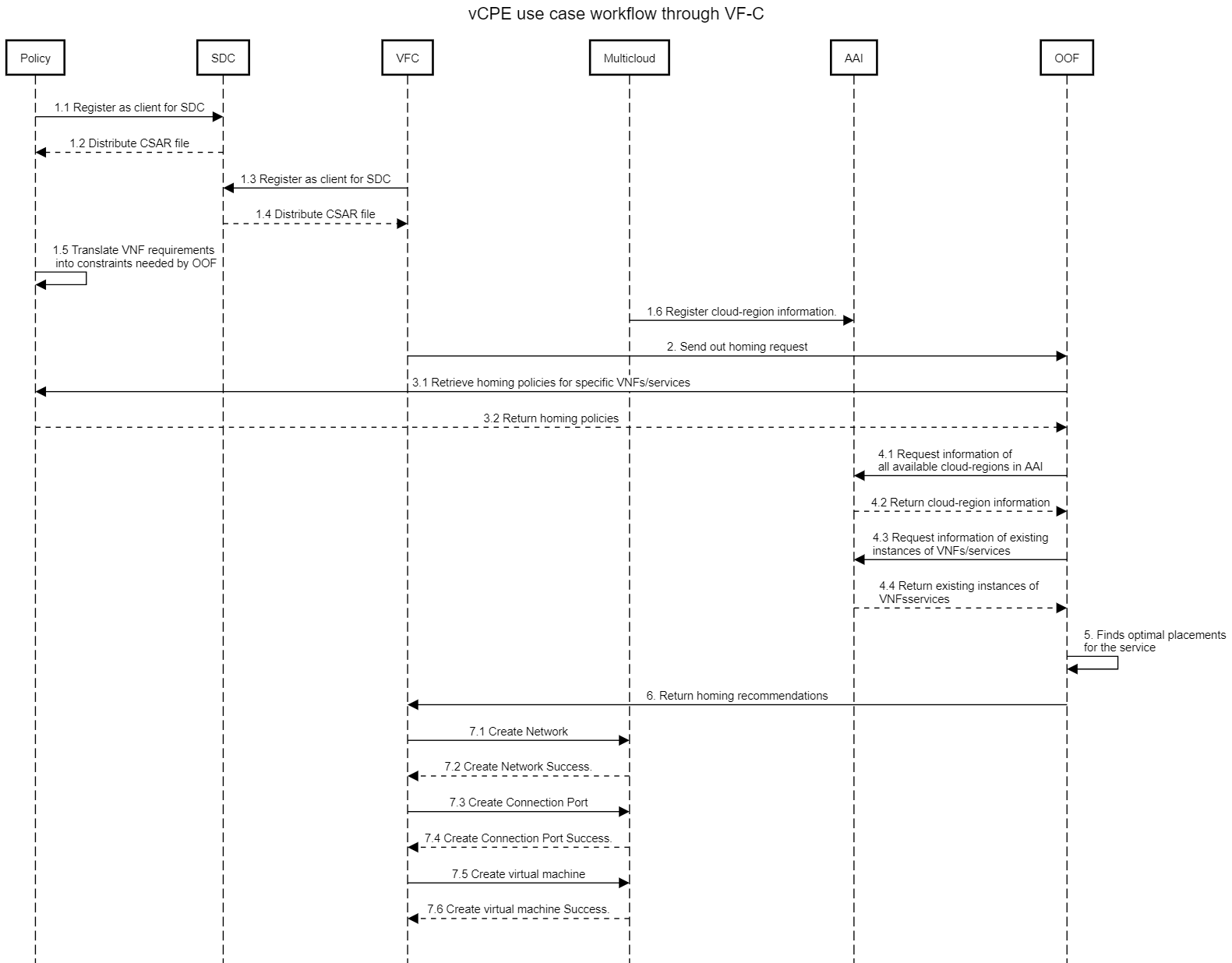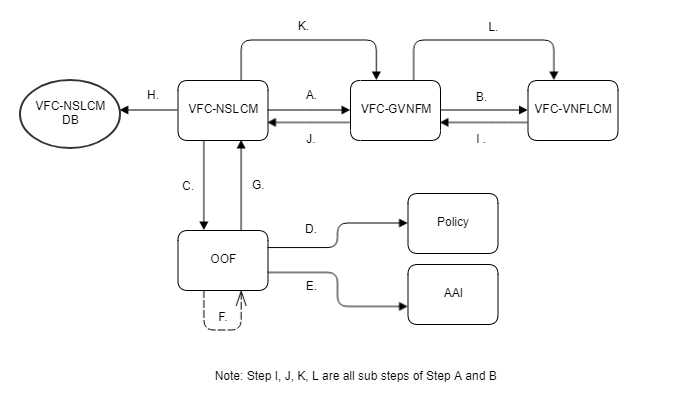You are viewing an old version of this page. View the current version.
Compare with Current
View Page History
« Previous
Version 12
Next »
DRAFT
This is a work in progress. Comments and suggestions gladly accepted. Draft will be removed once this is finalized.
HPA VF-C External Sequence Flow for Casablanca
vCPE use case workflow through VF-C

HPA VF-C External API Interaction for Casablanca
SDC
Supported HPA Capability Requirements(DRAFT)#LogicalNodei/ORequirements is referred.
SDC will provide below HPA information to VF-C
Logical Node i/O Requirements
Capability Name | Capability Value | Descriptiopn |
|---|
Capability Name | Capability Value | Descriptiopn |
|---|
pciVendorId |
| PCI-SIG vendor ID for the device |
pciDeviceId |
| PCI-SIG device ID for the device |
pciNumDevices |
| Number of PCI devices required. |
pciAddress |
| Geographic location of the PCI device via the standard PCI-SIG addressing model of Domain:Bus:device:function |
pciDeviceLocalToNumaNode | required notRequired | Determines if I/O device affinity is required. |
Network Interface Requirements
Capability Name | Capability Value | Description |
|---|
nicFeature | LSO, LRO, RSS, RDMA | Long list of NIC related items such as LSO, LRO, RSS, RDMA, etc. |
dataProcessingAccelerationLibray | Dpdk_Version | Name and version of the data processing acceleration library required. Orchestration can match any NIC that is known to be compatible with the specified library. |
interfaceType | Virtio, PCI-Passthrough, SR-IOV, E1000, RTL8139, PCNET | Network interface type |
vendorSpecificNicFeature | TBA | List of vendor specific NIC related items. |
OOF
A. VFC-NSLCM calls VFC-GVNFM driver through RESTful api to create VNF.
B. VFC-GVNFM invokes VFC-VNFLCM through RESTful api to do the
creation(which requires bunch of time) and returns the VNF information(Almost synchronous).
( I. VFC-LCM calls VFC-GVNFM to apply for grant.
J. VFC-GVNFM driver invokes VFC-NSLCM to provide the grant info.
K. VFC-NSLCM provides grant info along with placement from OOF to VFC-GVNFM driver
L. VFC-GVNFM transmits the information to VFC-VNFLCM to go through
the following steps for instantiation.)
During the creation period(Step B.):
C. VFC-NSLCM calls OOF for homing allocation service using the VNF information returned.
D. OOF calls POLICY to retrieve related policies for such service/VNF.
E. OOF calls AAI to get all available cloud regions or existing instances inside the database.
F. OOF processes the homing allocation.
G. OOF respond to VFC-NSLCM with the optimal placement.
H. VFC-NSLCM stores the data returned by OOF into its database.
The integration between OOF and VFC can be divided into 4 phases:
- VFC send out homing request to OOF(Step C.)
- OOF retrieve the requirements(policies) for that service/VNF inside Policy(Step D.)
- OOF check AAI database for existing instances/available cloud regions(Step E.)
- OOF process homing allocation and return homing placement to VFC (Step F. and G.)
VFC send out homing request to OOF
A module inside NSLCM will call OOF to get homing allocation placement. And it will use the same API using by SO. Sample request using these API:
{
"requestInfo": {
"transactionId": "2441780a-2710-4169-91ee-a9f52a705bb3 //UUID",
"requestId": "2441780a-2710-4169-91ee-a9f52a705bb3 //UUID",
"callbackUrl": "<callback URL from VFC>",
"sourceId": "vfc",
"requestType": "create",
"numSolutions": 1,
"optimizers": [
"placement"
],
"timeout": 600
},
"placementInfo": {
"placementDemands": [
{
"resourceModuleName": "vBRG //<VNF name from CSAR>",
"serviceResourceId": "<vnfInstanceId used inside VFC>",
"resourceModelInfo": {
"modelInvariantId": "no-resourceModelInvariantId",
"modelVersionId": "no-resourceModelVersionId"
}
}
]
},
"serviceInfo":
{
"serviceInstanceId": "9fd24064-a335-478c-bbb0-3b71b7fbc55f",
"serviceName": "vcpe",
"modelInfo": {
"modelInvariantId": "31390ef2-94a9-4cef-a09a-08f7d66540c9 //Id get from CSAR",
"modelVersionId": "1a32426f-3616-47d0-96eb-b20cc7fff9be //Id get from CSAR"
}
}
}
OOF retrieve the requirements(policies) for that service/VNF inside Policy
Based on the request from VF-C, OOF need to retrieve policies for that VNF/service. Sample Policy schema will look like this:
#
#Example 1: vCPE, Basic Capability and pciePassthrough
#one VNFC(VFC) with one basic capability requirement and two pciePassthrough requirements
#
{
"service": "hpaPolicy",
"policyName": "oofCasablanca.hpaPolicy_vFW",
"description": "HPA policy for vFW",
"templateVersion": "0.0.1",
"version": "1.0",
"priority": "3",
"riskType": "test",
"riskLevel": "2",
"guard": "False",
"content": {
"resources": "vG",
"identity": "hpaPolicy_vG",
"policyScope": ["vCPE", "US", "INTERNATIONAL", "ip", "vG"],
"policyType": "hpaPolicy",
"flavorFeatures": [
{
"id" : "<vdu.Name>",
"type":"vnfc/tocsa.nodes.nfv.Vdu.Compute",
"directives":[
{
"directive_name":"flavor_directive",
"attributes":[
{
"attribute_name":"<Blank, or use Default value String 'flavor_name'>",
"attribute_value": "<Blank>"
}
]
}
],
"flavorProperties": [
{
"hpa-feature": "basicCapabilities",
"mandatory": "True",
"architecture": "generic",
"hpa-feature-attributes": [
{ "hpa-attribute-key": "numVirtualCpu", "hpa-attribute-value": "6", "operator": "=", "unit": "" }
]
},
{
"hpa-feature": "basicCapabilities",
"mandatory": "True",
"architecture": "generic",
"hpa-feature-attributes": [
{ "hpa-attribute-key": "virtualMemSize", "hpa-attribute-value": "6", "operator": "=", "unit": "GB" },
]
},
{
"hpa-feature": "pciePassthrough",
"mandatory": "True",
"architecture": "generic",
"directives" : [
{
"directive_name": "pciePassthrough_directive",
"attributes": [
{ "attribute_name": "<Blank>",
"attribute_value": "<Blank>"
},
{ "attribute_name": "<Blank>",
"attribute_value": "<Blank>"
}
]
}
],
"hpa-feature-attributes": [
{ "hpa-attribute-key": "pciVendorId", "hpa-attribute-value": "1234", "operator": "=", "unit": "" },
{ "hpa-attribute-key": "pciDeviceId", "hpa-attribute-value": "5678", "operator": "=", "unit": "" },
{ "hpa-attribute-key": "pciCount", "hpa-attribute-value": "1", "operator": ">=", "unit": "" }
]
},
{
"hpa-feature": "pciePassthrough",
"mandatory": "True",
"architecture": "generic",
"directives" : [
{
"directive_name": "pciePassthrough_directive",
"attributes": [
{ "attribute_name": "<Blank>",
"attribute_value": "<Blank>"
}
{ "attribute_name": "<Blank>",
"attribute_value": "<Blank>"
}
]
}
],
"hpa-feature-attributes": [
{ "hpa-attribute-key": "pciVendorId", "hpa-attribute-value": "3333", "operator": "=", "unit": "" },
{ "hpa-attribute-key": "pciDeviceId", "hpa-attribute-value": "7777", "operator": "=", "unit": "" },
{ "hpa-attribute-key": "pciCount", "hpa-attribute-value": "1", "operator": ">=", "unit": "" }
]
}
]
}
]
}
}
OOF check AAI database for existing instances/available cloud regions
The data in AAI still follows the routine schema designed in HPA Policies and Mappings. The only part has been changed is inside pciePassthrough. We added one 'directive' attributes to contain the 'vnic_type' and 'physicalNetwork' that needed by VF-C.
Here we just provide data for one sample flavor including the requirements for the previous example:
hpa-capability-id="b369fd3d-0b15-44e1-81b2-6210efc6dff9",
hpa-feature= "basicCapabilities",
architecture= "generic",
version= "v1",
hpa-attribute-key hpa-attribute-value
numVirtualCpu {value:6}
virtualMemSize {value:6, unit:"GB"}
hpa-capability-id="f453fd3d-0b15-11w4-81b2-6210efc6dff9",
hpa-feature= "pciePassthrough",
architecture= "intel64",
version= "v1",
hpa-attribute-key hpa-attribute-value
pciCount {value: 1}
pciVendorId {value: "8086"}
pciDeviceId {value: "0443"}
directive {value: "[{"attribute_name"="vnic_type", "attribute_value"="direct"},
{"attribute_name"="physical_network", "attribute_value"="physnet1"}]"}
hpa-capability-id="f453fd3d-0b15-11w4-81b2-873hf8oo98s0",
hpa-feature= "pciePassthrough",
architecture= "intel64",
version= "v1",
hpa-attribute-key hpa-attribute-value
pciCount {value: 1}
pciVendorId {value: "6808"}
pciDeviceId {value: "3440"}
directive {value: "[{"attribute_name"="vnic_type", "attribute_value"="direct"},
{"attribute_name"="physical_network", "attribute_value"="physnet2"}]"}
OOF process homing allocation and return homing placement to VF-C
OOF will match the requirements inside the policies with the data of the available candidates(cloud-regions or existing candiates) to find an optimal solution to place that service.
After OOF gives out the most appropriate placement for that VNF/services, it will respond the solution back to VF-C with schema like below. Then a module in NSLCM will get that response and store them inside its Database for later instantiation.
{
"requestId": "xxxx",
"transactionId": " xxxx ",
"statusMessage": " xxxx ",
"requestStatus": "completed",
"solutions": {
"placementSolutions": [
[
{ "resourceModuleName": " vG ",
"serviceResourceId": " xxxx ",
"solution": {
"identifierType": "serviceInstanceId",
"identifiers": [
" xxxx "
],
"cloudOwner": " xxxx "
},
"assignmentInfo": [
{ "key":"isRehome",
"value":"false" },
{ "key":"locationId",
"value":"DLLSTX1A" },
{ "key":"locationType",
"value":"openstack-cloud" },
{ "key":"vimId",
"value":"rackspace_DLLSTX1A" },
{ "key":"physicalLocationId",
"value":"DLLSTX1223" },
{ "key":"oofDirectives",
"value": { "directives":[
{ "id":"<vdu.name>",
"type":"vnfc",
"directives":[
{ "type":"flavor_directive",
"attributes":[
{ "attribute_name":"flavor_name", //just a string 'flavor_name'
"attribute_value":"<flavor_name>" #VIM Flavor, which oof seleted.
}
]
},
{ "type": "pciePassthrough_directive",
"attributes":[
{"attribute_name":"vnic_type", "attribute_value":"direct"},
{"attribute_name":"provider_network", "attribute_value":"physnet1"}
]
},
{ "type": "pciePassthrough_directive",
"attributes": [
{"attribute_name":"vnic_type", "attribute_value":"direct"},
{"attribute_name":"provider_network", "attribute_value":"physnet2"}
]
}
]
}
]
}
}
]
}
]
],
"licenseSoutions": [
{
"resourceModuleName": "string",
"serviceResourceId": "string",
"entitlementPoolUUID": [
"string"
],
"licenseKeyGroupUUID": [
"string"
],
"entitlementPoolInvariantUUID": [
"string"
],
"licenseKeyGroupInvariantUUID": [
"string"
]
}
]
}
}
MultiCloud
HPA VF-C Casablanca Stories
| Key
|
Summary
|
T
|
Created
|
Updated
|
Due
|
Assignee
|
Reporter
|
P
|
Status
|
Resolution
|

